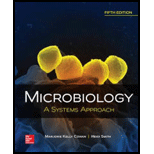
Microbiology: A Systems Approach
5th Edition
ISBN: 9781259706615
Author: Marjorie Kelly Cowan Professor
Publisher: McGraw-Hill Education
expand_more
expand_more
format_list_bulleted
Concept explainers
Textbook Question
Chapter 24.1, Problem 2AYP
Summarize why our view of the abundance of microbes on earth has changed in recent years.
Expert Solution & Answer
Want to see the full answer?
Check out a sample textbook solution
Students have asked these similar questions
Briefly state the physical meaning of the electrocapillary equation (Lippman equation).
Explain in a small summary how:
What genetic information can be obtained from a Punnet square? What genetic information cannot be determined from a Punnet square?
Why might a Punnet Square be beneficial to understanding genetics/inheritance?
In a small summary write down:
Chapter 24 Solutions
Microbiology: A Systems Approach
Ch. 24.1 - Define microbial ecology.Ch. 24.1 - Summarize why our view of the abundance of...Ch. 24.1 - Prob. 3AYPCh. 24.1 - Prob. 4AYPCh. 24.1 - Prob. 5AYPCh. 24.2 - List five important elements of biogeochemical...Ch. 24.2 - Diagram a carbon cycle.Ch. 24.2 - Prob. 8AYPCh. 24.2 - Prob. 9AYPCh. 24.2 - Describe the process of nitrogen fixation, and...
Ch. 24.2 - Prob. 11AYPCh. 24.3 - Prob. 12AYPCh. 24.3 - Prob. 13AYPCh. 24.3 - Prob. 14AYPCh. 24.3 - Prob. 15AYPCh. 24.3 - Prob. 16AYPCh. 24.3 - Prob. 17AYPCh. 24.4 - Prob. 18AYPCh. 24.4 - Prob. 19AYPCh. 24 - Which of the following is not a major subdivision...Ch. 24 - Prob. 2MCQCh. 24 - Prob. 3MCQCh. 24 - Prob. 4MCQCh. 24 - Root nodules contain ______, which can ________....Ch. 24 - Prob. 6MCQCh. 24 - Prob. 7MCQCh. 24 - Prob. 8MCQCh. 24 - Prob. 9MCQCh. 24 - Recent studies reveal that a. 100% of...Ch. 24 - Prob. 11TFCh. 24 - Prob. 12TFCh. 24 - Prob. 13TFCh. 24 - A plastisphere is a specialized ball used when...Ch. 24 - Prob. 15TFCh. 24 - Prob. 1CTQCh. 24 - a. Outline the general characteristics of a...Ch. 24 - Summarize the role microbes play in the cycling of...Ch. 24 - Many people use animal manure to fertilize their...Ch. 24 - PCBs are human-made pollutants that are not...Ch. 24 - Prob. 1VCCh. 24 - From chapter 8, figure 8.24. What process does...Ch. 24 - Prob. 1CM
Knowledge Booster
Learn more about
Need a deep-dive on the concept behind this application? Look no further. Learn more about this topic, biology and related others by exploring similar questions and additional content below.Similar questions
- Not part of a graded assignment, from a past midtermarrow_forwardNoggin mutation: The mouse, one of the phenotypic consequences of Noggin mutationis mispatterning of the spinal cord, in the posterior region of the mouse embryo, suchthat in the hindlimb region the more ventral fates are lost, and the dorsal Pax3 domain isexpanded. (this experiment is not in the lectures).a. Hypothesis for why: What would be your hypothesis for why the ventral fatesare lost and dorsal fates expanded? Include in your answer the words notochord,BMP, SHH and either (or both of) surface ectoderm or lateral plate mesodermarrow_forwardNot part of a graded assignment, from a past midtermarrow_forward
- Explain in a flowcharts organazing the words down below: genetics Chromosomes Inheritance DNA & Genes Mutations Proteinsarrow_forwardplease helparrow_forwardWhat does the heavy dark line along collecting duct tell us about water reabsorption in this individual at this time? What does the heavy dark line along collecting duct tell us about ADH secretion in this individual at this time?arrow_forward
arrow_back_ios
SEE MORE QUESTIONS
arrow_forward_ios
Recommended textbooks for you
- Basic Clinical Lab Competencies for Respiratory C...NursingISBN:9781285244662Author:WhitePublisher:Cengage
 Concepts of BiologyBiologyISBN:9781938168116Author:Samantha Fowler, Rebecca Roush, James WisePublisher:OpenStax College
Concepts of BiologyBiologyISBN:9781938168116Author:Samantha Fowler, Rebecca Roush, James WisePublisher:OpenStax College
 Biology 2eBiologyISBN:9781947172517Author:Matthew Douglas, Jung Choi, Mary Ann ClarkPublisher:OpenStax
Biology 2eBiologyISBN:9781947172517Author:Matthew Douglas, Jung Choi, Mary Ann ClarkPublisher:OpenStax Biology Today and Tomorrow without Physiology (Mi...BiologyISBN:9781305117396Author:Cecie Starr, Christine Evers, Lisa StarrPublisher:Cengage Learning
Biology Today and Tomorrow without Physiology (Mi...BiologyISBN:9781305117396Author:Cecie Starr, Christine Evers, Lisa StarrPublisher:Cengage Learning

Basic Clinical Lab Competencies for Respiratory C...
Nursing
ISBN:9781285244662
Author:White
Publisher:Cengage

Concepts of Biology
Biology
ISBN:9781938168116
Author:Samantha Fowler, Rebecca Roush, James Wise
Publisher:OpenStax College


Biology 2e
Biology
ISBN:9781947172517
Author:Matthew Douglas, Jung Choi, Mary Ann Clark
Publisher:OpenStax


Biology Today and Tomorrow without Physiology (Mi...
Biology
ISBN:9781305117396
Author:Cecie Starr, Christine Evers, Lisa Starr
Publisher:Cengage Learning
Explore Terrestrial Habitats - Types of Habitats for Children; Author: Smile and Learn - English;https://www.youtube.com/watch?v=vv1indKgOHQ;License: Standard youtube license